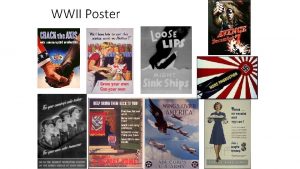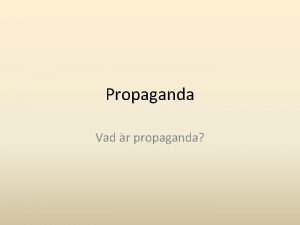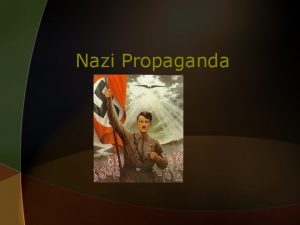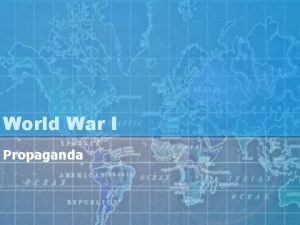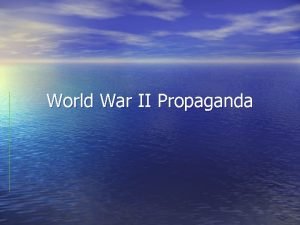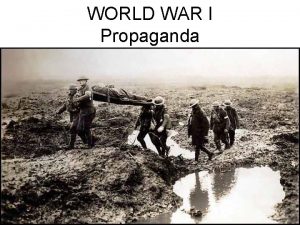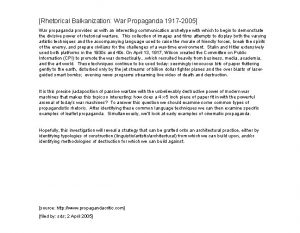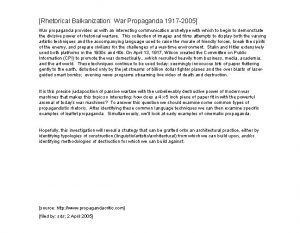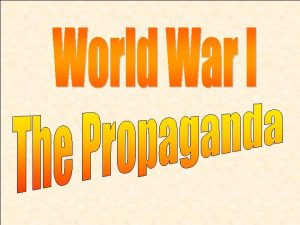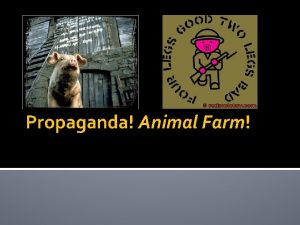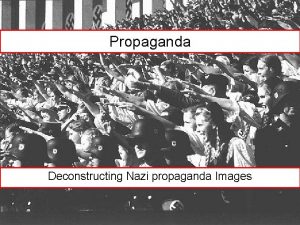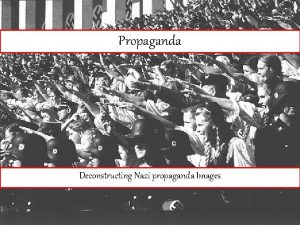World War I Propaganda Definition Propaganda is defined












- Slides: 12

World War I Propaganda

Definition Propaganda is defined as: Information, ideas or rumors deliberately spread to help or harm a person, group, movement, institution, nation, etc.

The Use of Propaganda • Justify involvement in the war • Solicit men to join • Procure money and resources to sustain their military campaign • Boost morale • Urge the public to save • Encourage the purchase of war bonds

Forms of Propaganda • • Speeches Photos Newsreels Magazines and newspaper articles • POSTERS

Propaganda Techniques • Bandwagon: persuading people to do something by letting them know others are doing it • Testimonial: using the words of a famous person to persuade

Propaganda Techniques • Transfer: using the names or pictures of famous people, but not direct quotations • Repetition: the product name is repeated at least four times • Emotional words: words that will make people feel strongly about someone or something

Techniques • Appeal to authority: quoting prominent figures to support a position, idea or course of action • Appeal to fear: building support by instilling anxiety and panic in the general population

Techniques • Black and white fallacy: providing only two choices (Ex. “you are either with us or you are with the enemy. ”) • Common man: using ordinary language and mannerisms to convince the audience that a position represents the common person

Techniques • Demonizing the enemy: making individuals from the opposing nation appear to be subhuman, worthless, or immoral through suggestion or false accusations

Techniques • Direct order: telling the audience exactly what actions to take and eliminating any other possible choices. • Flag-waving: justifying an action on the grounds that doing so will make one more patriotic

Techniques • Oversimplification: providing simple answers to complex social, political, economic, or military problems • Virtue words: using words that tend to produce a positive image when attached to a person or issue. (Ex. peace, , happiness, security, wise leadership, freedom)

Example
 Bandwagon propaganda posters
Bandwagon propaganda posters Techniques used in world war ii propaganda
Techniques used in world war ii propaganda Not well defined set examples
Not well defined set examples Sides of cold war
Sides of cold war Total war world history definition
Total war world history definition War at home vs war abroad madison
War at home vs war abroad madison Description
Description Welcome 1 unit 10 lesson 1
Welcome 1 unit 10 lesson 1 Sclc and sncc venn diagram
Sclc and sncc venn diagram Was josette dugas pro war
Was josette dugas pro war Sein remse
Sein remse Contact force examples
Contact force examples Why was the civil war the first modern war
Why was the civil war the first modern war
